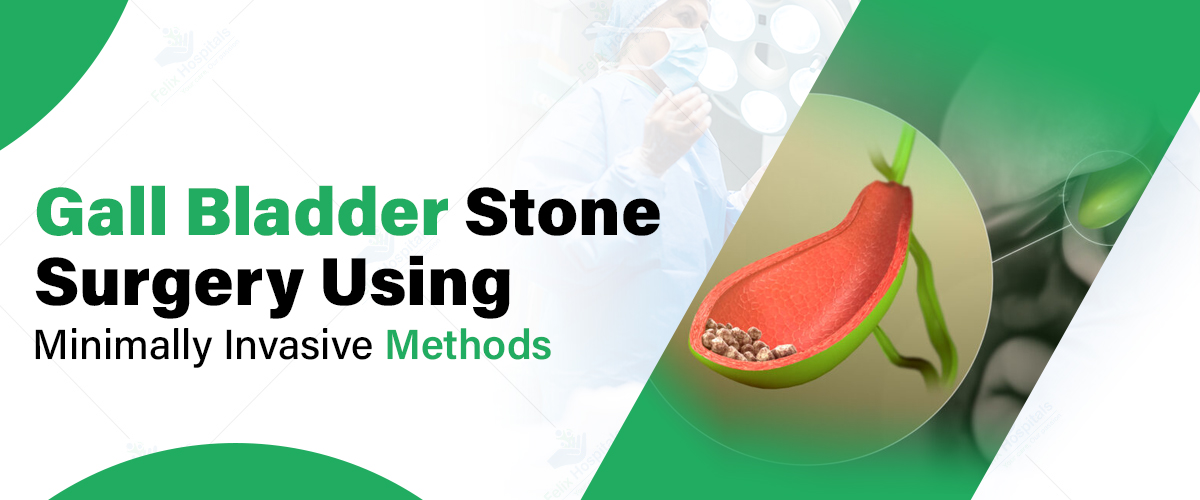
Subscribe to our

Gallbladder stone surgery using minimally invasive methods, commonly known as laparoscopic cholecystectomy, offers a modern approach to treat gallstones with reduced complications and a quicker recovery time compared to traditional open surgery. With advancements in technology, laparoscopic surgery offered by gallbladder stone surgery hospital has become the most preferred method for many patients, providing effective treatment for gallbladder stones with minimal discomfort.
Looking for a consultation from the comfort of your home? Discover our teleconsultation services by calling +91 9667064100 today!
Gallbladder stone surgery, or cholecystectomy, is typically performed when gallstones lead to significant health issues. Gallstones are small crystalline deposits that form in the gallbladder which sometimes can cause severe discomfort and complications which require surgical intervention to relieve symptoms and prevent further health problems.
Additionally gallbladder stone surgery is required to:
Minimally invasive techniques have improved the treatment of gallstones by offering a less traumatic alternative to traditional surgery. Procedures like laparoscopic cholecystectomy involve making small abdominal incisions through which a camera and specialized instruments are inserted and used to remove the gallbladder. This approach reduces tissue damage, postoperative pain, and recovery time compared to open surgery.
Additionally, advancements in non-surgical treatments, such as extracorporeal shock wave lithotripsy (ESWL) and endoscopic procedures, enable the fragmentation and removal of gallstones with minimal impact on the body. These new methods make patients more comfortable and help them get back to their normal activities faster.
When it comes to treating gallstones, patients now have access to several minimally invasive techniques offered by the best gallbladder stone surgeon which act as a less troublemaking alternative to traditional surgery. These advanced methods aim to alleviate symptoms, reduce recovery time, and improve overall patient comfort.
Here are some key minimally invasive methods for managing gallstones:
1-Laparoscopic Cholecystectomy: This is a surgery where doctors make small cuts in the abdomen and use a tiny camera and special tools to take out the gallbladder. It’s less invasive and usually has a quicker recovery than traditional surgery.
2-Endoscopic Retrograde Cholangiopancreatography (ERCP): This procedure involves using a flexible tube with a camera to look inside the bile ducts and remove any gallstones blocking them.
3-Percutaneous Gallbladder Drainage: This technique involves inserting a needle through the skin to drain away infected or swollen bile from the gallbladder, helping to relieve pain and infection.
4-Shock Wave Lithotripsy (SWL): This method uses powerful shock waves directed at gallstones to break them into smaller pieces so they can pass through the body more easily.
Minimally invasive methods for treating gallstones offer a variety of benefits compared to traditional surgical approaches. The advantages of these methods include:
Overall, minimally invasive surgery offers significant advantages in terms of comfort, recovery time, and cosmetic outcomes. Moreover, the Gallbladder stone removal surgery cost in Noida is reasonably priced, making it a popular choice for many patients suffering from gallstones.
Recovery after minimally invasive surgery for gallstones is typically faster and more comfortable than with traditional surgical methods. Patients often experience less post-operative pain, reduced scarring, and a quicker return to normal activities. Most individuals can resume light activities within a few days and return to full activities within a few weeks, depending on their overall health and specific procedure.
Dr. Ritesh Agarwal
Dr. Ritesh Agarwal specializes in minimally invasive surgery for gallstones, offering patients a modern approach to treatment that involves smaller incisions and less recovery time. With his skillful techniques, Dr. Agarwal provides effective and comfortable solutions for gallstone removal, prioritizing both precision and patient well-being.
Have questions? Get them answered by experts. Call +91 9667064100 or simply click here.
Gallbladder stone surgery using minimally invasive methods stands out as one of the best choice for patients due to its numerous benefits as compared to traditional methods. As a result, patients experience faster returns to their daily activities and overall improved outcomes, making minimally invasive surgery the optimal solution for managing gallbladder stones.
1-When is surgery required for removing gallstones?
ANS: Surgery is typically required when gallstones cause significant pain, recurrent inflammation, or complications such as pancreatitis or cholangitis. The decision is based on symptoms and potential risks.
2-How long does laparoscopic cholecystectomy take?
ANS: Laparoscopic cholecystectomy usually takes about 1 to 2 hours. The duration can vary depending on the complexity of the case and the patient’s anatomy.
3-Does a 1.5 cm gallstone need surgery?
ANS: A 1.5 cm gallstone might require surgery if it causes symptoms or complications. The size alone isn’t the sole factor; symptoms and overall health are crucial in the decision-making process.
4-Why remove the gallbladder instead of just the stones?
ANS: Removing the gallbladder prevents future stone formation and complications, as gallstones often recur if the gallbladder is left in place. It’s a more permanent solution for managing gallbladder disease.
5-Can gallstones regenerate after surgery treatment?
ANS: After gallbladder removal, gallstones cannot regenerate because the gallbladder, which produces and stores bile that can form stones, is gone. However, patients can still experience bile duct stones or other issues.
6-Can gallstones be treated without gallbladder removal?
ANS: Yes, gallstones can sometimes be managed with non-surgical methods like medication or shock wave therapy. However, these treatments might not be as effective or permanent as gallbladder removal.